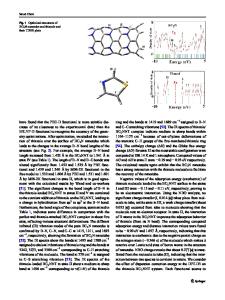A DFT and wave function theory study of hydrogen adsorption on small beryllium oxide clusters
- PDF / 863,351 Bytes
- 10 Pages / 595.276 x 790.866 pts Page_size
- 39 Downloads / 332 Views
REGULAR ARTICLE
A DFT and wave function theory study of hydrogen adsorption on small beryllium oxide clusters Orlando Roberto‑Neto1 · Edson Firmino Viana de Carvalho2 Received: 17 December 2019 / Accepted: 6 May 2020 © Springer-Verlag GmbH Germany, part of Springer Nature 2020
Abstract In the last centuries, human society has strongly modified the biosphere of the planet through consumption of its resources on a highly increasing scale but without planning, causing pollution in various environments through chemical dumping, and the extensive use of fossil fuels in industrialization and transportation, for example. In this last aspect, the use of less polluting alternative fuels for vehicular transport based on the consumption of electricity and hydrogen gas has been suggested. Experimental and theoretical studies are being made to increase the hydrogen storage capacity using porous carbon materials, nanoparticles, and metallic clusters. Most of the electronic and structure calculations of such materials have been carried out with density functional theory (DFT) without gauging the accuracy of the employed DFTs. In this work, we have employed various DFTs to calculate hydrogen adsorption energies of small clusters of BeO and compare with wave function theory methods, in order to evaluate the relative accuracy of these methodologies, since experimental values are not usually available. The hydrogen storage capability of small clusters of (BeO)n (n = 2–7) is studied with various density functionals, MP2, and CCSD(T) methods and benchmarked with the complete basis set (CBS) limit approach. Calculated properties are the equilibrium geometries of isolated and adsorbed clusters with H2, electronic adsorption energy, enthalpy, and Gibbs free energy. Calculations with the CBS method are employed to gauge the accuracy of various methods in calculating structures and cohesive energies of small beryllium clusters. The smallest values of mean unsigned error of the cohesive energies (Eb) calculated with the ωB97X-D, TPPSh, and M06-L DFTs are equal to 0.05, 0.06, and 0.07 eV using as reference the CBSD-T. Keywords (BeO)n clusters · Equilibrium structures · Density functional theory · CBS limit method · Hydrogen adsorption energy
1 Introduction
Festschrift in honor of Prof. Fernando R. Ornellas” Guest Edited by Adélia Justino Aguiar Aquino, Antonio Gustavo Sampaio de Oliveira Filho & Francisco Bolivar Correto Machado. Electronic supplementary material The online version of this article (https://doi.org/10.1007/s00214-020-02605-z) contains supplementary material, which is available to authorized users. * Orlando Roberto‑Neto [email protected] 1
Divisão de Aerotermodinâmica e Hipersônica, Instituto de Estudos Avançados, São José dos Campos, São Paulo 12228‑001, Brazil
Departamento de Física, Universidade Federal do Maranhão, São Luís, Maranhão 65085‑580, Brazil
2
The human impact on the global environment, as global heating and disruptive modification on the carbon balance distribution on the planet shows tha
Data Loading...











